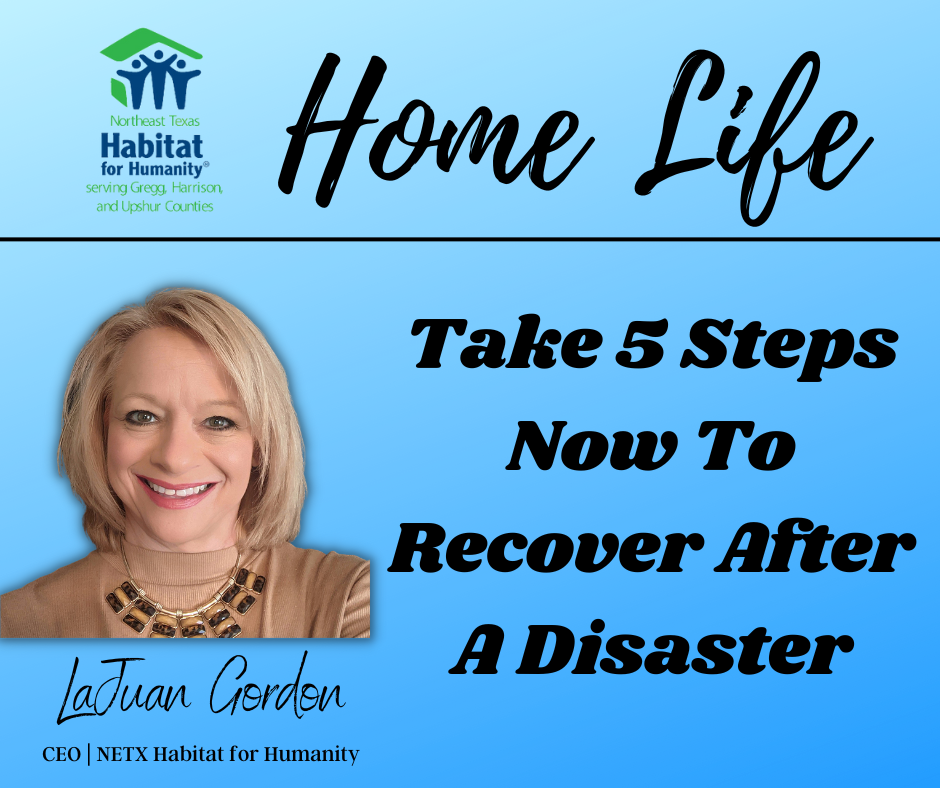
It is spring in Texas. While most of us are cleaning up flower and vegetable beds to prepare for planting, attending spring festivals and ball games, and basking in the warm days, East Texans are also watching the skies Why? Spring is tornado season!
Disasters can strike at any moment and without much notice. We can’t control nature, but we can better protect our households and recover quicker, by preparing for the unexpected.
There are five steps that you can take now, to recover better should disaster strike.
(1) Learn about the natural disasters most likely to happen where you live.
In the NE Texas Habitat service region of Gregg, Harrison, and Upshur counties, a tornado is the highest threat, with flooding and wildfire registering as low to medium level threats. Visit the Natural Hazard Explorer to input any location in the U.S. and learn about the natural disasters most likely to occur in your region.
As you follow the next four steps, adjust your preparations for the unique challenges of the disasters most likely to impact you.
(2) Review your insurance coverages.
Ensure you have proper coverage in sufficient amounts to replace losses or provide needed medical care. Property and health policies can be complicated to interpret. Your agent or HR rep is the expert and can help you confirm proper coverage or make needed adjustments.
(3) Make a Family Plan
Disasters may not occur when all members of a family are together. Likewise, many of us have older relatives or other adult family members that don’t live in the same home. Hold a family meeting and map a communication plan for your family. The plan should include:
- Can We Talk? Agreements and instructions on how you will communicate. In a disaster internet, landlines, or cell towers may not be fully functional or could be overloaded. But texts can often get around local networks when phones cannot.
- Teach children how and when to dial 9-1-1 on landlines and cell phones
- Teach everyone how to send and check text messages.
- Assign an Information Captain – The Information Captain is one person to receive family check-in texts or calls and to manage updates for extended family and friends. Assign a backup person, in case the original individual cannot respond. An out-of-town relative or close family friend works well for this situation.
- Choose a Meet-up Spot-Pre-determine a location, away from the disaster zone for the family to meet. Choose a backup location outside of your community in the event the meeting place is involved in the disaster.
- Get the App(s) –Subscribe to local emergency alert services. Most communities have systems that will send texts, calls and/or emails with warnings, safety instructions, and the latest updates during the disaster. The American Red Cross Safe and Well App features an “I’m Safe” button that will post to your social media pages to let friends and family know you are out of harm’s way. Get it free from the AppStore or on Google Play.
- Write it down. Prepare a laminated card for everyone that contains contact information for the Information Captain and backup, family, and emergency services, the meeting place and backup, and the web address for the American Red Cross Safe and Well website. Carry the list on your person, purse or backpack at all times and place a copy in the disaster kit.
- Practice, Practice, Practice. Review and update the information and practice a mock disaster- preferably every six months, but at least annually.
- This template can help you get started Emergency Plan Template
- Note: If you live in a hurricane or wildfire area, visit Ready.Gov Disasters for preparation and evacuation preparedness tips information. At minimum:
- Follow evacuation orders and routes as instructed.
- Keep a half talk of gas in your car at all times. During an evacuation, roads will be congested and gas pumps may be inoperable or depleted quickly.
- Take your disaster kit, emergency food and water( enough for three days for each person. One gallon of water per day per person), medications, and important documents with you.
- Keep masks in your car to help protect against respiratory hazards.
(4) Build a Disaster Kit.
The disaster kit should be designed with the household’s unique characteristics and most likely disasters in mind. Items needed to evacuate pre-disaster differ from items you will need to shelter in place or leave a damaged home. However; everyone should include:
- Medications and first aid supplies
- Copies of important documents- insurance and banking information identification, emergency medical information.
- Hygiene supplies
- Nonperishable food and water. A manual can opener – 3-day supply
- One complete change of clothing and closed-toe sturdy shoes
- Comfort items- jacket, blanket, rain poncho, small toys, books, and games
- Cash
- Cell phone charger and power bank
- Light source ( battery operated )
- Batteries
A suggested list of inclusions and links to more information follows this article.
Considerations when choosing kit containers.
- The primary container needs to be sturdy and air, water, and pest proof.
- Size and portability matter. Consider dimensions, weight, and ease of transport.
- Group the contents into categories, package them separately, and place them into the primary container.
- Important documents should be stored in fire and waterproof packaging.
- Do not store battery-operated items with the batteries installed. A battery can corrode and damage functionality.
(5) Practice the Plan and Maintain the Kit.
- Practice disaster drills every six months or at least annually.
- Examine the disaster kit, every three to six months to replace or update:
- Expired food, drink, and medication
- Important documents
- Check functionality of flashlights, lanterns, radios, and other battery-operated devices.
- Replace expired batteries
- Consider the changing household: For example, a new baby will require diapers, formula, and clothing. Has a pet joined or left your home? Occasionally family members’ health changes and the first aid kit needs to be adapted.
- Note: Adding drill and kit examination appointments to your calendars is an easy way to remember this important safety task
Suggested kit inclusions:
- Water — one gallon per person, per day, for at least three days.
- Food — at least a three-day supply of nonperishable items.
- Manual can opener
- Scissors or utility knife
- Blankets/sleeping bags/pillows/towels.
- Closed-toe, sturdy shoes
- Jacket or coat, rain gear
- NOAA weather radio or other battery-powered radio
- Flashlight.
- Extra batteries.
- Important documents — copies of insurance policies, identification, bank account records and emergency medical information, contact information for family, physicians and workplace.
- Cash.
- Dust masks to help filter contaminated air.
- Plastic sheeting and duct tape to shelter in place.
- Garbage bags.
- Whistle
- Basic tools such as a wrench, pliers and screwdriver.
- Local maps.
- Cell phone, charger, power bank.
- Personal hygiene items and feminine supplies.
- First aid kit.
Optional items
- Paper cups, plates, paper towels and plastic utensils.
- Extra clothes that can be washed by hand and hung dry.
- Matches in a waterproof container.
- Fire extinguisher.
- Household chlorine bleach and medicine droppers.
- Books, games, puzzles or other activities for children.
- Two-way radios.
For your pet
- Photocopies of medical records and photos of your pets for identification purposes.
- Medications.
- Feeding dishes and at least a three-day supply of food and water.
- Disposable litter trays and litter.
- Extra collar or harness and leash.
- Blanket and toys.
- Sturdy pet carrier.
- Important information and the name and telephone number of your veterinarian.
Additional resources
- Pet disaster preparedness and supplies and products from the American Red Cross
- Disaster preparedness for pets from the American Society for the Prevention of Cruelty to Animals
- Step-by-step actions to prepare for an emergency from the Centers for Disease Control and Prevention
- “Make a plan” from Ready Campaign
- Federal Emergency Management Agency
- NOAA Weather Radio All Hazards
- Emergency supply kits from Quake are
- Disaster supply kit from Weather Underground
LaJuan Gordon, is currently the Chief Executive Officer of Northeast Texas Habitat for Humanity. She has twenty-five years of experience in the non-profit industry including executive leadership, consulting, program development, and resource development. Gordon holds a Certificate of Emergency Management and worked for six years in nonprofit disaster preparedness and response, including deployment, standing up disaster resource centers and information and referral hotlines, and leading workshops on disaster planning for individuals and businesses.
